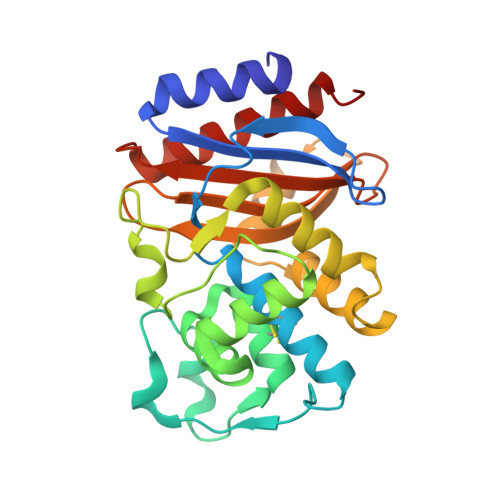Design and exploration of novel boronic acid inhibitors reveals important interactions with a clavulanic acid-resistant sulfhydryl-variable (SHV) beta-lactamase.
Winkler, M.L., Rodkey, E.A., Taracila, M.A., Drawz, S.M., Bethel, C.R., Papp-Wallace, K.M., Smith, K.M., Xu, Y., Dwulit-Smith, J.R., Romagnoli, C., Caselli, E., Prati, F., van den Akker, F., Bonomo, R.A.(2013) J Med Chem 56: 1084-1097
- PubMed: 23252553
- DOI: https://doi.org/10.1021/jm301490d
- Primary Citation of Related Structures:
4FCF - PubMed Abstract:
Inhibitor resistant (IR) class A ¦Â-lactamases pose a significant threat to many current antibiotic combinations. The K234R substitution in the SHV ¦Â-lactamase, from Klebsiella pneumoniae , results in resistance to ampicillin/clavulanate. After site-saturation mutagenesis of Lys-234 in SHV, microbiological and biochemical characterization of the resulting ¦Â-lactamases revealed that only -Arg conferred resistance to ampicillin/clavulanate. X-ray crystallography revealed two conformations of Arg-234 and Ser-130 in SHV K234R. The movement of Ser-130 is the principal cause of the observed clavulanate resistance. A panel of boronic acid inhibitors was designed and tested against SHV-1 and SHV K234R. A chiral ampicillin analogue was discovered to have a 2.4 ¡À 0.2 nM K(i) for SHV K234R; the chiral ampicillin analogue formed a more complex hydrogen-bonding network in SHV K234R vs SHV-1. Consideration of the spatial position of Ser-130 and Lys-234 and this hydrogen-bonding network will be important in the design of novel antibiotics targeting IR ¦Â-lactamases.
Organizational Affiliation:
Department of Microbiology and Molecular Biology, Case Western Reserve University, Cleveland, Ohio 44106, USA.
















